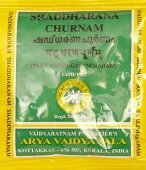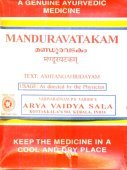Gomutra, Gomūtra, Go-mutra: 17 definitions
Introduction:
Gomutra means something in Buddhism, Pali, Hinduism, Sanskrit, Marathi. If you want to know the exact meaning, history, etymology or English translation of this term then check out the descriptions on this page. Add your comment or reference to a book if you want to contribute to this summary article.
In Hinduism
Ayurveda (science of life)
Rasashastra (Alchemy and Herbo-Mineral preparations)
Source: Wisdom Library: Rasa-śāstraGomūtra (गोमूत्र) refers to “cow’s urine”. It is used in Ayurvedic literature such as the Rasaprakāśasudhākara (Sanskrit book on rasaśāstra, or ‘Indian medicinal alchemy’).
Toxicology (Study and Treatment of poison)
Source: Ancient Science of Life: Śodhana: An Ayurvedic process for detoxificationGomūtra (गोमूत्र) refers to the urine of Bos indicus, and is one of the ingredients considered useful when treating “poisonous plants” (viṣa) using the Śodhana process, which involves the purification as well as reduction in the levels of toxic principles according to Ayurvedic principles.—Ayurvedic classics (viz., the 17th-century Yogaratnakara) have emphasized various methods of Śodhana to overcome the undesired effects from various poisonous and non-poisonous drugs, involving different media specific to substances such as Godugdha (milk of Bos indicus), Gomūtra (urine of Bos indicus), Triphalā (combination of three fruits, Terminalia chebula, Terminalia bellarica and Emblica officinalis) and lemon juice etc.
It has been reported that Gomūtra (“cow’s urine”) converts Aconite to a compound with cardiac stimulant property, whereas, raw Aconite showed cardiac depressant properties. Śodhana by both Gomūtra and Godugdha (“cow’s milk”) makes Aconite devoid of cardiac and neuro–muscular toxic effects without affecting its antipyretic activity.
Veterinary Medicine (The study and treatment of Animals)
Source: Asian Agri-History: Paśu Āyurvēda (Veterinary Medicine) in GaruḍapurāṇaGomūtra (गोमूत्र) refers to “cow’s-urine” and is used in the treatment of various disorders, according to sections on Horses (Gajāyurveda or Aśvāyurveda) in the Garuḍapurāṇa.—[Management of miscellaneous disorders]—The drugs along with decoction of triphalā are advised if the horse is affected by vraṇa (ulcers)/kuṣṭha/khañja (lameness). The medicines should be administered with gomūtra (cow’s-urine) in mandāgni (impaired digestion), śotharoga (swelling/oedema). If they are affected by vātapitta, vraṇa (ulcers) the ghṛtasaṃyukta-gokṣīra (cow's milk along with ghee) is advised. If the horse is kṛṣa (emaciated), the diet shall be supplemented by māṃsa (meat) for puṣṭyārtha (to improve the body).

Āyurveda (आयुर्वेद, ayurveda) is a branch of Indian science dealing with medicine, herbalism, taxology, anatomy, surgery, alchemy and related topics. Traditional practice of Āyurveda in ancient India dates back to at least the first millenium BC. Literature is commonly written in Sanskrit using various poetic metres.
Purana and Itihasa (epic history)
Source: Shodhganga: The saurapurana - a critical studyGomutra (गोमुत्र) (“urine of the cow”) represents the food taken in the month Mārgaśīrṣa for the Kṛṣṇāṣṭamī-Vrata, according to the 10th century Saurapurāṇa: one of the various Upapurāṇas depicting Śaivism.—Accordingly, the Kṛṣṇāṣṭamī-vrata is observed in honour of Śiva. [...] It starts from the month of Mārgaśira. It is observed on the eighth tithi of the dark fortnight and for a year.—In Mārgaśīrṣa, the performer having controlled his sense-organs should brush his teeth with the piece of aśvattha-wood. Taking bath and performing tarpaṇa, should worship Śaṅkara. He should fast for the day and only gomutra (“urine of the cow”) is to be taken as food in the night. By this a person gets the result more than eight times that of atirātra sacrifice.

The Purana (पुराण, purāṇas) refers to Sanskrit literature preserving ancient India’s vast cultural history, including historical legends, religious ceremonies, various arts and sciences. The eighteen mahapuranas total over 400,000 shlokas (metrical couplets) and date to at least several centuries BCE.
Vastushastra (architecture)
Source: Brill: Śaivism and the Tantric Traditions (architecture)Gomūtra (गोमूत्र) refers to the “urine of a cow”, according to the Devyāmata (in the section śalyoddhāra-paṭala or “excavation of extraneous substances”).—Accordingly, “[...] If a cow [which has entered the site] urinates (gomūtra—gavāṃ mūtreṇa) or drops dung, there are pieces of silver or gold [beneath the site, respectively]. If a cat urinates or drops dung, [the officiant] should prognosticate a piece of iron or an inauspicious thing (? aśam) [beneath the site,] respectively”.

Vastushastra (वास्तुशास्त्र, vāstuśāstra) refers to the ancient Indian science (shastra) of architecture (vastu), dealing with topics such architecture, sculpture, town-building, fort building and various other constructions. Vastu also deals with the philosophy of the architectural relation with the cosmic universe.
Sports, Arts and Entertainment (wordly enjoyments)
Source: archive.org: Syainika Sastra of Rudradeva with English Translation (art)Gomūtra (गोमूत्र) refers to “cow’s urine” (used in the treatment of hawks), according to the Śyainika-śāstra: a Sanskrit treatise dealing with the divisions and benefits of Hunting and Hawking, written by Rājā Rudradeva (or Candradeva) in possibly the 13th century.—Accordingly, [while discussing the treatment of hawks]: “If a hawk does not bathe through fear, and lice with their eggs thrive in its body, to radically destroy them, a powder of long pepper should be scattered over, or the bark of the root of Bel pounded with cow’s urine (gomūtra) should be plastered over its body. There is no doubt that this destroys lice with their eggs”.

This section covers the skills and profiencies of the Kalas (“performing arts”) and Shastras (“sciences”) involving ancient Indian traditions of sports, games, arts, entertainment, love-making and other means of wordly enjoyments. Traditionally these topics were dealt with in Sanskrit treatises explaing the philosophy and the justification of enjoying the pleasures of the senses.
In Buddhism
Tibetan Buddhism (Vajrayana or tantric Buddhism)
Source: OSU Press: Cakrasamvara SamadhiGomūtra (गोमूत्र) refers to “cow urine”, according to the purification (śodhana) of the Pañcagavya (five cow products) ritual often performed in combination with the Cakrasaṃvara Samādhi, which refers to the primary pūjā and sādhanā practice of Newah Mahāyāna-Vajrayāna Buddhists in Nepal.—Accordingly, “[...] Oṃ purified with conch-water Hūṃ. [Give water to patrons.] Cow urine (gomūtra), cow dung, milk, curd, ghee, holy grass, (and) water, The forementioned Pañcagavya and holy grass purifies the body. Oṃ purified with conch-water Hūṃ. [Give water again]”.

Tibetan Buddhism includes schools such as Nyingma, Kadampa, Kagyu and Gelug. Their primary canon of literature is divided in two broad categories: The Kangyur, which consists of Buddha’s words, and the Tengyur, which includes commentaries from various sources. Esotericism and tantra techniques (vajrayāna) are collected indepently.
Languages of India and abroad
Marathi-English dictionary
Source: DDSA: The Molesworth Marathi and English Dictionarygōmūtra (गोमूत्र).—n (S) Cow's urine.
Source: DDSA: The Aryabhusan school dictionary, Marathi-Englishgōmūtra (गोमूत्र).—n Cow's urine.
Marathi is an Indo-European language having over 70 million native speakers people in (predominantly) Maharashtra India. Marathi, like many other Indo-Aryan languages, evolved from early forms of Prakrit, which itself is a subset of Sanskrit, one of the most ancient languages of the world.
Sanskrit dictionary
Source: DDSA: The practical Sanskrit-English dictionaryGomūtra (गोमूत्र).—cow's urine.
Derivable forms: gomūtram (गोमूत्रम्).
Gomūtra is a Sanskrit compound consisting of the terms go and mūtra (मूत्र).
Source: Cologne Digital Sanskrit Dictionaries: Shabda-Sagara Sanskrit-English DictionaryGomūtra (गोमूत्र).—n.
(-traṃ) Cow's urine. E. go, and mūtra urine. ṣaṣṭhītatpuruṣaḥ .
Source: Cologne Digital Sanskrit Dictionaries: Cappeller Sanskrit-English DictionaryGomūtra (गोमूत्र).—[neuter] a cow’s urine.
Source: Cologne Digital Sanskrit Dictionaries: Monier-Williams Sanskrit-English Dictionary1) Gomūtra (गोमूत्र):—[=go-mūtra] [from go] n. cow’s urine, [Kāṭhaka; Kātyāyana-śrauta-sūtra xxv; Kauśika-sūtra; Manu-smṛti] etc.
2) [v.s. ...] m. [plural] Name of a family, [Pravara texts v, 4]
Source: Cologne Digital Sanskrit Dictionaries: Yates Sanskrit-English DictionaryGomūtra (गोमूत्र):—[go-mūtra] (traṃ) 1. n. Cow’s urine.
[Sanskrit to German]
Sanskrit, also spelled संस्कृतम् (saṃskṛtam), is an ancient language of India commonly seen as the grandmother of the Indo-European language family (even English!). Closely allied with Prakrit and Pali, Sanskrit is more exhaustive in both grammar and terms and has the most extensive collection of literature in the world, greatly surpassing its sister-languages Greek and Latin.
Kannada-English dictionary
Source: Alar: Kannada-English corpusGōmūtra (ಗೋಮೂತ್ರ):—
1) [noun] the urine of cattle.
2) [noun] the zigzag mark on the ground made by the urine passed out by a cow while walking.
3) [noun] a particular stance or manner of striking in mace-fight.
Kannada is a Dravidian language (as opposed to the Indo-European language family) mainly spoken in the southwestern region of India.
See also (Relevant definitions)
Starts with: Gomutrabha, Gomutragamdhi, Gomutrajati, Gomutraka, Gomutrasamagandha, Gomutrike.
Ends with: Ardhagomutra.
Full-text (+35): Gomutrajati, Gomutraka, Gamutra, Gomitra, Gombhas, Gomutrike, Santapana, Gomutrika, Kricchrasamtapana, Langali, Cow urine, Godugdha, Paryushita, Dolayantra, Bhallataka, Kustumburu, Samyukta, Vatapitta, Ghritasamyukta, Gokshira.
Relevant text
Search found 10 books and stories containing Gomutra, Go-mutra, Go-mūtra, Gō-mūtra, Gomūtra, Gōmūtra; (plurals include: Gomutras, mutras, mūtras, Gomūtras, Gōmūtras). You can also click to the full overview containing English textual excerpts. Below are direct links for the most relevant articles:
Garga Samhita (English) (by Danavir Goswami)
Verses 5.24.19-21 < [Chapter 24 - The Killing of the Kola Demon]
Verses 4.14.19-20 < [Chapter 14 - The Story of the Jālandharīs]
Verses 5.7.16-17 < [Chapter 7 - The Killing of Kuvalayāpīḍa]
Rasa Jala Nidhi, vol 2: Minerals (uparasa) (by Bhudeb Mookerjee)
Part 1 - Characteristics of Shilajatu or Shilajit (bitumen) < [Chapter IV - Uparasa (4): Shilajatu or Shilajit (bitumen)]
Manusmriti with the Commentary of Medhatithi (by Ganganatha Jha)
Verse 11.212 < [Section XXIX - Description of the Expiatory Penances]
Puranic encyclopaedia (by Vettam Mani)
The Agni Purana (by N. Gangadharan)
Chapter 91 - Different kinds of mantras for the worship of God
Chapter 252 - The mode of wielding the swords, maces etc.
Chapter 288 - The management of the horses (aśvavāhana-sāra)
Middle Chola Temples (by S. R. Balasubrahmanyam)
Temples in Tirumukkudal < [Vira Rajendra]
Related products



